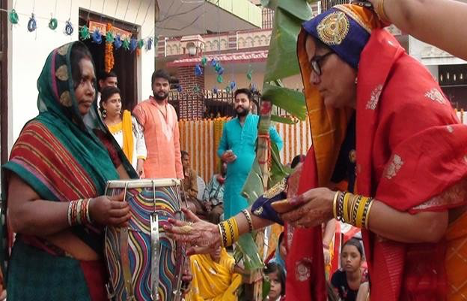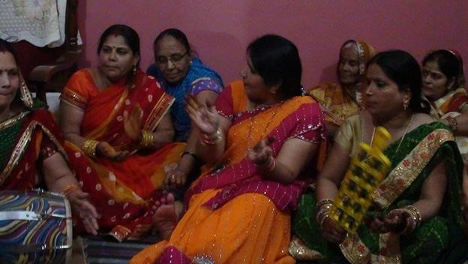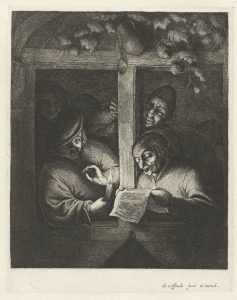Blogs, essays and reviews by members of the Song Studies Network. Do you want to contribute? Contact us!
A Study of the Hardi Ritual and its Songs
by Bidisha Chakraborty, Banaras Hindu University
The Bhojpuri community mostly found along the Indo-Gangetic plains, comprises the districts of western Bihar, eastern Uttar Pradesh, Jharkhand, and borders of Nepal. The Bhojpuri community is deeply engaged with rituals and rites. Songs from a significant part of the ritual events without which no north Indian marriage is considered complete. In Indian culture, turmeric (hardi or haldi) is considered felicitous to a marriage. Here, I will talk about my ethnographic work concerning a particular marriage ritual: the hardi ceremony of the Bhojpuri community and the its hardi songs. During one of my visits to Bhadwar, a village in Bihar, I asked a field informant why turmeric paste was applied. She told me that the hardi ritual is essential and informed me that vermillion (kumkum) and turmeric are said to be markers of a married woman, the asuhaagan.

There is a popular saying in Bhojpuri, says another field informant: O re hardiya sarbe gunadar surati ude hai bhagwan – O turmeric! you have every great property to adorn a face with the divine glow. Turmeric is an antioxidant that keeps the bride and the bridegroom healthy. Also, the turmeric paste is applied to protect the bride and bridegroom from evil forces. It is believed that turmeric, with all its antibacterial properties, makes our skin healthier.
In India, most marriages are arranged, and often perceived to be between the two families rather than between two people alone. During the wedding ceremony, the relatives come forward and apply the hardi, which is a form of giving blessings as well as their approval of the match. The hardi is applied five times on the bride and bridegroom, stretched over three to five days. Nowadays, due to a shortage of time, the hardi ritual is completed in one single day. After the tilak, the pre-wedding ceremony, where the bridegroom’s family promises the bride’s family that the wedding can’t be canceled anymore, the hardi ritual begins. The woman who grinds the hardi has to be from the barber caste and is called the naun. For both the bride and the groom the respective aunts (bua) mix the turmeric with mustard oil.

The woman who wears the green sari is the barber’s wife (naun). She plays an important part in all the wedding rituals. Ghazipur, Uttar Pradesh, 21 November 2019.Since songs are an important part of the wedding ritual, the musical instrument that is used (the dholak), is also worshipped and salved with the turmeric paste. The women of the house sing hardi songs. For the bride, the hardi ceremony takes place in a tent (marwa) made of bamboo sticks (balla). For the groom, a bamboo stick is planted with some kush strains (harish), and then the hardi is applied. It is said: Mahila hardi leptin hai, purush chadhate hai – Women smear turmeric all over the body while men put the turmeric on the cheeks.
First, five male members, and then five married women of the family apply hardi. The men of the household use a mango leaf (pallav), or grass shoots (durba), to apply the paste. They don’t touch the bride or the bridegroom. Five or seven married women come together to apply the hardi and then the others follow. The women smear the paste all over the body and face. One of the songs that I collected in Ghazipur in November 2019 goes as follows:
Age mai, hardi hardiya duva patar na (4)
Age mai, kaun baba hardiya chadhawela na (4)
Age mai baba se baba apan baba na
Age mai uhe baba hardi chadhawela na (2)
Age mai hardi hardiya duva patar na (2)
Age mai kaun chacha hardiya chadhawela na (4)
Age mai chacha se chacha apan chacha na
Age mai uhe chacha hardiya chadawela na (2)
Age mai hardi hardiya duva patar na (2)
Age mai kaun mama hardi chadhawale na (4)
Age mai mama se mama apan mama na
Age mai uhe mama apan mama na (2)
Age mai hardi hardiya duva patar na (4)
O! Mother, the hardi is yellow, with grass shoots and leaves
O! Mother, which father salves the hardi?
O! Mother, the father, our father, our dearest father
O! Mother, our father salves the hardi.
O! Mother, the hardi is yellow, with grass shoots and leaves
O! Mother, which paternal uncle salves the hardi?
O! Mother, the paternal uncle, our paternal uncle, our dearest paternal uncle;
O! Mother, our uncle salves the hardi.
O! Mother, the hardi is yellow, with grass shoots and leaves
O! Mother, which maternal uncle salves the hardi?
O! Mother, the maternal uncle, our maternal uncle, our dearest maternal uncle;
O! Mother, our maternal uncle salves the hardi.
O! Mother, the hardi is yellow, with grass shoots and leaves
O! Mother, which brother salves the hardi?
O! Mother, the brother, our brother, our dearest brother;
O! Mother, our dear brother salves the hardi.
No ritual is complete without the songs. Once a ritual begins, the women come together to sing the songs related to the rituals. Since these performances occur within the framework of socially sanctioned religious and ritual events, these are some of the few available spaces for women to come together within their families without any restrictions. These occasions provide women to come together, share their stories, and create significant networks with one another. These Bhojpuri songs suggest that they are particularly important sites for the expressions of women’s negotiations of their social worlds. This hardi song was sung by a group of women, during the ceremony, when the men of the family began the hardi ritual.
It was my field trip to Bhadwar, a village in Buxar, Bihar where I witnessed the final application of hardi on the bride. After the first hardi is applied, the girl is not allowed to take a bath. She can only take a bath after the final application of the turmeric paste. After completion of the hardi ritual five times, the bride is taken for a bath (nacchu nahawn), after which the wedding begins. Since I got access to the inner chambers, I saw how the women rubbed hardi to cleanse and beautify the bride. This is an act to adorn and prepare the girl for her conjugal life. Reena Devi, a forty-two-year-old married woman from Ghazipur, Uttar Pradesh, tells me that ‘Hardi’ is an important ritual in a north Indian wedding.

In a traditional marriage, the women’s singing begins a week before the actual wedding ceremony. The women of the household are joined by relatives, neighbours and acquaintances and will sing songs through the whole night. These events give a sense of belonging and strengthen their community feeling. Through songs we have always tried to understand women’s agency and their sense of self. These hardi songs, embedded within the micro politics of home and kinship, suggest that they are particularly important sites to understand the position of women in the social world.
Bidisha Chakraborty is a PhD student at the department of English at Banaras Hindu University, Varanasi. Her thesis is on Bhojpuri wedding songs, titled ‘Ritual, Music and Emotion; A study of Bhojpuri Wedding Songs’ .
Sensing Songs
by Stewart Campbell , University of Birmingham
In the previous blog post Renée Vulto highlighted the ability of singing to facilitate feelings of belonging and community, and the role of singing in maintaining collective identities. Using recent examples from the COVID-19 pandemic, the images of music on balconies reminds us of singing’s ability to connect people locally, nationally, and internationally. In commenting on the song Bella Ciao, Renée observed that even if you were unaware of the song’s historical connotations you will sense ‘the belligerent character of this song and feel strengthened by it’. This idea of sensing songs prompted me to reflect on the varying ways we interact with a song.
In my own research I investigate songs as live audience experiences. I am interested in the ways individuals engage with music and words in songs and how people construct their own realities of live songs. I focus on how audience members describe their encounters with live songs, what features of songs they prioritise and neglect, and the language they use to describe their song encounters.
Vulto’s choice of language in sensing [the character] of a song is useful to help us reflect on the volume of sensory information we process when engaging with live songs. One way to think about a song is not as a fixed output that we consume, but instead as a process of negotiation between human cognitive functions and the various features encountered within songs and their environments.
When we engage with songs, we collect information from a complex network of sources. As I interact with the song Bella Ciao in the video clip below I engage with auditory information. This includes musical features (for example melody, form, rhythm) but also lexical features (for example language and words). I unfortunately do not speak Italian and in my own research audiences place different value on the need to understand the language a song is presented in order to understand what a song expresses. For example, for some people understanding the meanings of words in a song is essential to their enjoyment of a song. A song’s meaning can be said to derive from the song’s words. For others the opposite was true and a song’s meaning can is expressed not through its words but through its sounds. These positions challenge us to think about where and how emotion is actually conveyed in songs: in the meanings of the words; in the sounds of these words; in the sounds of other musical features; in the singing, or playing of instruments; or in none or all of these things.
My association with the song Bella Ciao song is first and foremost through engaging with this video and through writing this blog post. My relationship with this song is new, it is unfamiliar, and unknown. I am aware of the song’s origins as a 19th century protest song and which I can identify in my interpretation of the lyrics. However, my first experience of this song is in the context of people singing this in a global pandemic and I share many of the sentiments expressed in the previous post blog post. This challenges us to think about the situatedness of songs, how this situatedness impacts how we make sense of songs, and how our first encounters of songs, and subsequent encounters shape how we make sense of songs.
As I interact with this song, I can hear a higher pitched voice that is dominant in the texture. I have nothing visually to refer to in order to identify the origin of this voice (it is unclear where this voice is coming from in the video). Nor do I have any pre-existing knowledge of the singers in the video. Despite this, I immediately classify this as a female voice and gender the singer as a female. I do not know this of course, and this might not be the case. This serves as a reminder that the human voice is one of the most gendered sounds we encounter in our daily lives. This challenges us to think about the relationships between the physical voice, the performed voice, and human interpretation and perception. Alongside gender, how we classify and perceive those involved in the creation and performance of songs ultimately affects how we make sense of songs too.
My interaction with the lexical features of this song included a visual element as I used a text translation from the internet. My brain therefore processed the words of the song both through what I heard and saw in the video, but also through what I read on the page. This reminds us that interlingual translation is a determinant factor of songs for many. Also, me following the Italian words and English translation, watching the video, and listening to the music challenges us to think about the focus of our attention when we interact with songs. I hope I am beginning to show the vast array of possible internal and external information that we process when we interact with songs. This includes many of the material features of songs I have talked about so far, but also the social features of the environments that surround them. For example, in my own research songs are usually presented in traditional concert halls where there are socially accepted ways of behaviour which impact how individuals interact with live songs. That is of course very different from interacting with song in my own home.
We can consider the features I have described in this blog post as components of complex interpretive song worlds. We might think of these as a collection of different spaces which we as audiences draw upon to process, experience, evaluate, and understand songs. Some of these spaces contain features that can be relatively stable over time and space, for example a song’s melody, or its words. Other spaces contain elements that are relatively unstable and change enormously from each interaction with a song. Throughout this blog post I have deliberately chosen the term interaction with songs. We do not passively receive songs but instead are more active and activated to shape songs from the variety of materials presented to us within a song, and from song environments. Paying attention to these interactions and thinking about sensing songs as a process of negotiation prompts more questions than answers. But in so doing allows us to appraise the nature and meaning of songs from fascinating new angles.
Stewart Campbell is a doctoral researcher in the UK. His research project Songs Without Borders is funded by the UK Arts and Humanities Research Council and is a collaboration between the University of Birmingham and Oxford Lieder.
Singing in the Time of Corona
by Renée Vulto, Ghent University
This piece has earlier been published on Early Modern Soundscapes and Over de Muur (in Dutch).
In this period of social distancing, videos of people singing together from their balconies appear everywhere on our social media. Some balconies house better performers than other balconies, but it doesn’t really matter whether your voice sounds like Cecilia Bartoli’s or whether you’ve only ever sung in the shower. What matters is that the singing breaks through the social isolation. These videos thus testify to the power of music to create and maintain communities.
My neighbours in Rome singing Bella Ciao ❤️🤍💚 pic.twitter.com/gu1NqNjlHQ
— Jessica Phelan (@JessicaLPhelan) March 13, 2020
In times of crisis, we become newly aware of our need for physical connectedness. Even though it is possible to stay in touch with other people through social media whenever we want, we also feel the need to gather not only virtually, but also physically – even if such gathering has to take place at the distance between one balcony and another. But why, once we’re on our balconies, do we start singing?
The Coronavirus crisis is not the first crisis that people have had to live through, and it is not the first crisis during which people have started singing. In times of social agitation, political turbulence or natural disasters, people have sung songs to create feelings of togetherness and solidify their social group. There are many examples of this to be found in the early modern period. In the sixteenth century, for example, at the time of the Reformation in Europe, singing played an important part in the construction of the new Protestant religious community. On the other end of this conflict, Catholics in Elizabethan England sang to maintain their community in the face of persecution. Those sentenced to death even continued singing at the stake in order to assert their religious identity and shape their martyrdom within a religious tradition.

Furthermore, many national anthems were first performed in times of crisis. Take, for example, the French Marseillaise, which started as a protest song in a political conflict, then went on to be used to define a new nation after the transformations caused by the French Revolution, and is now still used to represent and strengthen French national identity. The collective singing of such a song confirms, time and time again, the community that is connected to that song.
The social isolation that has today been imposed on many of us, and which singing can help us resist, can be compared to other situations as well, including the experience of (in)voluntary migration. Through music, migrants have often tried to keep a connection with their original community. Just think of the music performed in many Irish pubs all over the world, or of the gospel choirs that maintain a worldwide religious community through singing. Enslaved African people started singing spirituals to stay connected to a community of fellow sufferers and draw strength from the knowledge of a shared faith.
Exile offers another historical ‘equivalent’ to our present moment. At the end of the eighteenth century, many Dutch revolutionaries had to flee the Dutch Republic after a failed uprising. From their new homes in France, England and Germany they kept on singing the songs that had driven their political movement. This helped to hold their scattered community together until they were able to successfully set in motion the Batavian Revolution and their return to the Netherlands.
In all these examples, singing is what keeps people connected. The voice is the one instrument that most people have access to, and everybody can sing to some degree. From the beginning of our history, music has helped us to create feelings of community, and to maintain collective identities. Some anthropologists even believe that music has played a central role in human evolution and in our survival as a species because the collective identities that are created when we make music together form the basis of the physical social groups that are essential for our existence. The bodily experience of making music together, of singing together, in which we act in synchrony, creates feelings of unity and togetherness. In times of crisis, we depend on the solidarity within the groups that we are a part of – our families, friends, neighbours; our local and national communities – not only to survive, but also for emotional, practical, and financial support (and supplies of toilet paper!).
A difficult situation like the COVID-19 pandemic thus shows us what we as humans return to when we feel vulnerable: musical ways of staying connected. It underlines the importance of social groups and the importance of music for maintaining such communities in difficult times. Even though we will not be able to go out for a while, we can keep singing because while singing is admittedly contagious, it does not transmit the Coronavirus. Therefore, stay safe and keep singing!
Renée Vulto, 20 April 2020